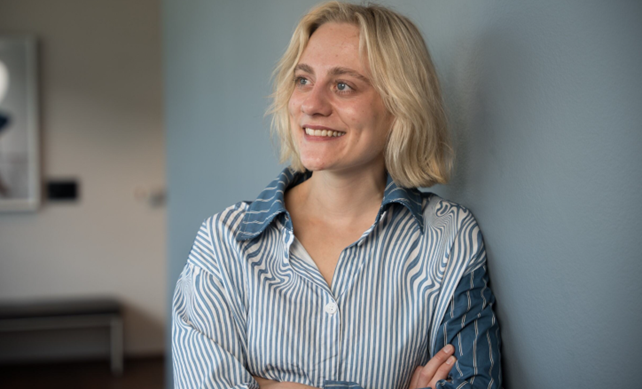Peer groups
Engineer: ‘People should meet me before they meet my diagnosis’

It's estimated that neurodivergent employees make up around 10-15% of the workforce and include people with ADHD, autism, dyslexia and OCD. Neurodivergence can often be shrouded in prejudice, which is why 26-year-old Katrine Rune was unsure how open she should be about her ADHD diagnosis when she entered the labour market a year and a half ago. Initially, Katrine had also asked to remain anonymous in this article because, as she says: ‘I want people to meet me before they meet my diagnosis.’
The concept of ‘neurodiversity’ is based on the understanding that people's brains function differently and that this is a natural part of human variation. Neurological differences should therefore not be seen as diseases or defects to be corrected. Instead, the challenges experienced by neurodivergent people should be understood as a reaction to societal barriers and lack of inclusion.
In the end, Katrine chose to come forward with her name, as she hopes it can break the taboo around neurodiversity and inspire others to be more open about their diagnosis:
‘I think it's a shame if someone feels they have to hide it. You don't necessarily have to talk about everything you're struggling with, but maybe through this article I can help remove some stigma and show that you can actually be an engineer and manage a job even if you have ADHD,’ she says.
Approaching transparency with caution
Katrine works as a sustainability engineer at DOMINIA Consulting Engineers, her first position. Fortunately, Katrine's workplace is very responsive and accommodating to her needs, but at first she was unsure how much to share about her diagnosis. After some deliberation, Katrine decided to be honest and open up the conversation herself into the open:
‘I like to control the story so that it's my story. Everyone is different, and that also applies when you have a diagnosis,’ she says.
Although Katrine's openness was welcomed, she finds that she quickly becomes overstimulated and struggles to manage her energy - she can forget to take breaks and concentrate so intensely that she eventually burns out. At one point, it got so bad that Katrine began to consider reducing her working hours. At the same time, she struggled with the feeling of not being good enough because she didn't feel she could live up to ‘traditional work norms’:
‘I feel like we as a society are constantly being told that we should work 37 hours, and right now there's this discourse that we're not actually working enough and not contributing to society,’ says Katrine.
Katrine's openness about her problems paid off here too: after a conversation with her manager, he and Katrine agreed that she should reduce her working hours, so she now works 35 hours with the option to increase or decrease the number of hours as needed.
‘And I can actually often stay longer because I don't feel like I have to stay just to stay,’ she says.
A peer group with room for diversity
As an IDA member, Katrine has had the opportunity to participate in a peer group for neurodivergent people, which has been a great help to her. The group has given her a sense of being met and understood without having to explain everything in detail:
‘I needed to find someone I could mirror myself in, who was also in the labour market. It was nice to meet others who were also neurodivergent and to feel welcomed and understood without having to explain. When I was considering taking time off, I discussed it in the group and realised that there were others who could relate to the doubts about being good enough if you did things a little differently,’ she says.
IDA offers two facilitated peer groups for neurodivergent people; one for those who thrive with a few people and a fixed agenda, and one for those who want to network with up to 14 others in a group where the agenda is more dynamic. Katrine is a member of the latter type of group, where participants have both ADHD and autism diagnoses. The different diagnoses can create different needs for the participants, and for Katrine, the most important thing about networking has been finding a place where she and others can be themselves:
‘It's really nice to be in a group where there's room for all of us and no one is ‘too much’ or ‘too little’, regardless of whether we're usually told otherwise,’ says Katrine.
The dynamic agenda has left room to bring up topics that the participants find relevant, and the group has discussed everything from energy management to social interactions in the workplace. An important part of the networking group's success, according to Katrine, is the presence of a facilitator who has guided the conversations and ensured that everyone had the opportunity to have their say:
‘Our facilitators have been really good at managing the dialogue and reminding us to take breaks. They helped make sure everyone was heard,’ says Katrine, and continues:
‘I would recommend anyone with a diagnosis to find a networking group. You really underestimate how much it can really mean to be with like-minded people. I come home every time with a lot more energy than I had before!’
Facts about neurodivergence
- The word neurodivergent means that the brain has non-typical characteristics associated with diagnoses such as ADHD, autism, OCD or dyslexia.
- The opposite of being neurodivergent is called being ‘neurotypical’, which means that your brain functions in the same way as the majority of the world's population.
- It is estimated that approximately 10-15% of the workforce is neurodivergent to one degree or another.
- The most common neurodivergent condition is dyslexia, which is part of life for approximately 10% of the adult population worldwide.
Are you interested in the peer group for neurodivergent IDA members?
IDA offers a facilitated peer group to help you share your experiences with other neurodivergent members.